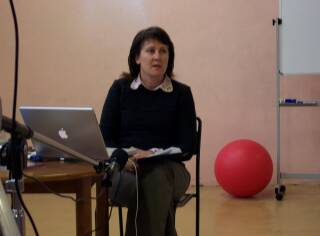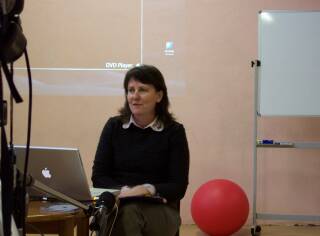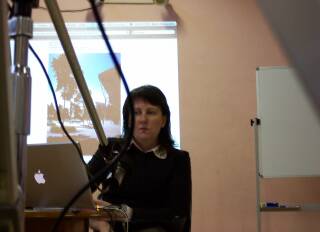


Sonia Leber - Sonic event spaces
reviewed by John Jenkins
Sonia Leber designs sound-based installations for public spaces – often in collaboration with her co-artist partner, the composer David Chesworth."David and I are very interested in the way people use cities and encounter and pass through urban spaces," she says.
For Leber, the site becomes both a ready-made context and stimulus for ideas. "Generally, we install 'interventions' in spaces already laden with objects, markers and meanings. When working in the public domain, the context is always half the work. So we enter the gaps and margins, to create a kind of rupture."
Leber says the notion of a 'rebellious use of space', as advocated by the 1960s 'Situationist' art movement in Paris, is relevant. She is aiming for "…short discrete interventions in public space, and taking materials already in use and shifting the context of their reception".
Leber and Chesworth make lengthy 'field' recordings from everyday life. The collaborators particularly collect 'proto-linguistic vocalisations' or expressive non-speech markers and exclamations (such as grunts, whistles, laughter, moans, sobs, cries, murmurs, loud intakes and exhalations of breath, gurgles, and so on). Such artistically 'naïve' material is then digitally re-composed, collage-like, into clusters - prior to being re-placed in new sites and contexts.
Their publicly sited work tends to be confrontational, loud, even aggressive, rather than delicate or subtle. "Our soundscapes in the public domain are so exclamatory; at times, bordering on belligerent - but in an uncanny or amusing way. They are often emphatic, demanding the attention of passersby - demanding that people stop and take notice."
The vocal fragments are "…shaped in ways that are stochastic, or ever-changing, using various levels and layers of file selection, randomisation and then spatial distribution… The works for public spaces can be thought of as re-configurations of individual voices into fabricated crowds."
The Gordon Assumption (2004), a piece in the Melbourne International Arts Festival, is an installation in a below ground ladies' toilet block in a small, lawn-covered roadside reserve in Gordon Place, central Melbourne.
Leber says of this work: "We hear a thick, shimmering cloud of voices Dozens of varied, but simultaneous, long, slowly rising tones, held in a quivering suspension. The effect is precarious, portentous, threatening to burst the limits of the subterranean chamber."
The cave-like, subterranean space can be thought of as "a site of transformation" or portal to another world. "In mythology and literature, voices emerge from caves: perhaps the voices of sibyls. Despite these themes, however, we wanted the work to remain inexplicable, mysterious and unresolved."
The piece was based on the so-called 'Shepard's tone paradox', which refers to sounds that seem to continuously rise in pitch. Actually, they are carefully configured to present a 'pitch perception paradox'. The sequence never seems to 'arrive' anywhere, despite its constant apparent movement.
The Master's Voice, a piece commissioned by the ACT Government Sculpture Program in 2001, was sited in the Canberra suburb of Civic, with speakers set low to the ground within the fringing wall of an urban pocket park. A series of 11 stainless steel grilles conceal and protect eight speakers, all inserted into the wall at rhythmic intervals. As people walk past the wall, they trigger "short sharp and arresting sounds – such as whistles, commands, instructions and shouting." The sounds were composed from recordings, of people talking to their pets and to working animals (including cats, dogs, elephants, seals, lions, giraffes, gorillas, peacocks, cattle, sheepdogs, horses, budgies and chickens!) The sounds seem to follow the passers-by along the path, in 40 second clusters.
The animals' response were edited out, so voices seem to be addressing the passers-by: "controlling, commanding, cajoling, coaxing". Listeners might, for an instant, imagine they were being individually called – and their movements and responses commented upon and assessed.
Next, they can stand back and watch things unfold, as a sort of impromptu theatrical event, when the next unwitting participant strolls down the path.
A work titled 5000 Calls (2000) is a permanent soundscape installation created for the exterior public domain surrounding Stadium Australia at Sydney's Olympic Park.
"In this threshold zone, David and I wanted to create a work which stimulated excitement, as many people passing through were in heightened states of anticipation, of stimulation and arousal. So we proposed another kind of crowd in our space outside the stadium, with 5000 Calls utilising 5000 individual human vocalisations. These include "…the sighs gasps and groans of work, pleasure, sport, song and struggle; the groan of a weightlifter; a celebratory shriek of new year reveller, a gasp of pain in the rehab patient."
The sounds are broadcast on site through 83 loudspeakers placed in the light poles throughout the 4.5 hectare site surrounding the stadium. Audience members are therefore surrounded by many audio speakers, with sounds arriving from near and afar.
The Persuaders (2003) is a multi-screen installation. Each screen shows a person who has been videotaped at home while watching football on television. For this piece, the video and audio fragments, all captured in real time, play out in different ways at different times to make a constantly changing 'crowd'.
"The sound of each person is also in 'close-up'", says Leber. "With apparent audio proximity, we can hear great detail in the breath and voice. Entering the darkened gallery space, visitors are confronted by the seven close-up 'persuaders' staring straight at them, calling out to them, addressing them with charged, emphatic vocalisations."
Leber says: "Throughout much of our recent work, including The Persuaders, we are very interested in the sounds and dynamics of crowds - and fascinated by a crowd phenomenon we call 'trans-arousal' or 'trans-kinesis'. It is a way of describing the 'reciprocal stimulation' of players and supporters, and of 'trans-stimulation' of individuals within the crowd."
"For instance," says Leber, "with crowd dynamics there might be a 'simultaneous surge', where the action of one person suddenly permeates the actions of many. Occasionally, we might witness universal expressions of exhilaration or buffoonery. There are also 'in-between' states – portentous and full of expectation – as the crowd is on the verge of becoming aroused in different ways. Part of the pleasure of the experience might be in the unpredictability of the dormant crowd as we wait for the next 'bursting forth' of activity."
